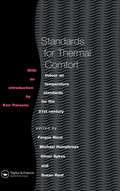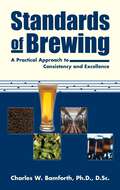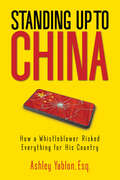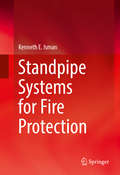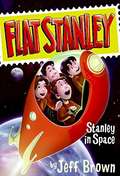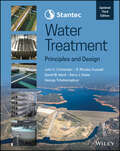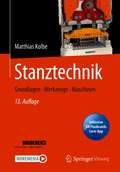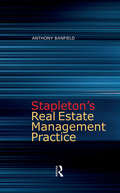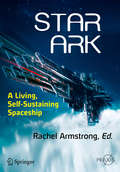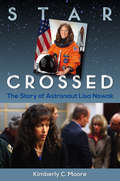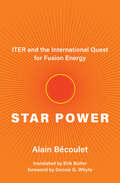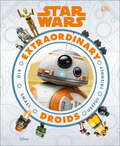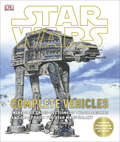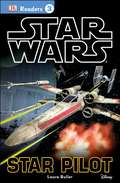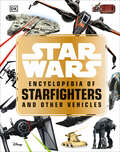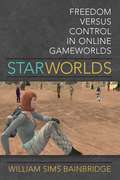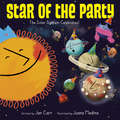- Table View
- List View
Standards for Thermal Comfort: Indoor air temperature standards for the 21st century
by M. Humphreys F. Nicol S. Roaf O. SykesCurrent Standards for Indoor Air Temperature are inappropriate in many regions of the world. This forces designers to use highly serviced buildings to achieve air temperatures that accord with the standards to the detriment of the local and global environment. Standards for Thermal Comfort brings together contributions from around the world, reflecting new approaches to the setting of standards which can apply to all climates and cultures.
Standards für alle: Eine Einführung in die (technische) Standardisierung
by Werner FellnerDieses Buch soll ein Bewusstsein wecken hinsichtlich der Notwendigkeit und Vorteile von innerbetrieblichen (technischen) Standards: Jedes Unternehmen hat das Ziel, effizient, innovativ und wirtschaftlich zu produzieren. Für eine effiziente Organisation und Erfüllung von zu berücksichtigenden Anforderungen können Standards maßgeblich zum Erfolg eines Unternehmens beitragen. Zu Beginn des Buches werden zu berücksichtigende Randbedingungen und Argumente für innerbetriebliche (technische) Standards aufgezeigt. Es folgen mögliche Einteilungskriterien, Definition und Grundlagen von Standards sowie deren Gestaltung und praktischen Anwendung. Im Anschluss wird das generelle Management und die Rollen im Standardisierungsprozesses beschrieben. Für eine konkrete Umsetzung in Unternehmen werden abschließend beispielhaft die grundlegenden und notwendigen Festlegungen der Standardisierung vorgestellt. Unterstützt durch viele Grafiken hilft dieses Buch beim Aufbau einer Standardisierung bzw. bei der Analyse bestehender innerbetrieblicher Standards und verschafft überraschende Einblicke in die Welt der Normen.
Standards of Brewing: Formulas for Consistency and Excellence
by Charles W. BamforthStandards of Brewing covers an essential topic for today&’s brewers: consistent production of quality product. With distribution expanding and competition intense, no brewery can afford to release product for distribution unless it is confident the beer will meet consumer expectations-even months after production. Bamforth covers the principles and practices of brewery quality so that brewers can establish or audit their own programs and procedures for producing consistent, high quality beer.
Standing Up to China: How a Whistleblower Risked Everything for His Country
by Ashley YablonWhat would you do if your ambitious career suddenly transformed into a deadly game of international espionage? A true-life thriller equal to that of a heart-stopping John Grisham novel, Ashley Yablon's story takes readers into the dark crevices of deceit and corporate greed of one of the world's most powerful Chinese telecom giants. As the freshly minted General Counsel for telecom company ZTE, Yablon uncovers an illegal scheme selling billions of dollars' worth of surveillance equipment to embargoed countries. If left unchecked, these transactions could threaten the security of the United States at the highest levels. Instead of turning a blind eye, Yablon risks everything, including his life and career, to uphold justice - leading him down a course of personal and professional destruction. In this modern-day story of David and Goliath, Yablon goes head-to-head with some of the most dangerous and powerful Chinese crime bosses in the world.
Standing up to Climate Change: Creating Prospects for a Sustainable Future in Rural Iran
by Shahrooz Mohajeri Lena Horlemann Ali A. Besalatpour Wolf RaberIn Iran, climate change combined with low adaptation capacity has an unparalleled impact on eco-systems as well as human livelihoods. The Roodasht region, in the lower part of the Zayandeh Rud basin in Central Iran, is severely affected by water scarcity, desertification and land degradation. This book describes the effects this has on the environment and society, analyzes the degree of vulnerability and suggests possible ways to improve land and water management. This book provides comprehensive and interdisciplinary insights into the environmental and social situation in the region, as well as possible solutions to deal with the current challenges. Written by German and Iranian scientists, NGO staff and government officials and bridging the gap between research and practical implementation, the book not only enhances our understanding of climate change and desertification, but also raises public awareness and promotes knowledge transfer between disciplines.
Standpipe Systems for Fire Protection
by Kenneth E. IsmanThis important new manual goes beyond the published NFPA standards on installation of standpipe systems to include the rules in the International Building Code, municipal fire codes, the National Fire Code of Canada, and information on inspection, testing, and maintenance of standpipe systems. Also covered are the interactions between standpipe and sprinkler systems, since these important fire protection systems are so frequently installed together. Illustrated with design examples and practical applications to reinforce the learning experience, this is the go-to reference for engineers, architects, design technicians, building inspectors, fire inspectors, and anyone that inspects, tests or maintains fire protection systems. Fire marshals and plan review authorities that have the responsibility for reviewing and accepting plans and hydraulic calculations for standpipe systems are also an important audience, as are firefighters who actually use standpipe systems. As a member of the committees responsible for some of these documents, Isman also covers the rules of these standards and codes as they are written, but also provides valuable insight as to the intent behind the rules. A noted author and lecturer, Professor Isman was an engineer with the National Fire Sprinkler Association (NFSA), is an elected Fellow of the Society of Fire Protection Engineers (SFPE), and currently Clinical Professor in the Department of Fire Protection Engineering at University of Maryland.
Standsicherheit von Staudämmen: Grundlagen, Berechnungen und Beispiele
by Thomas Ferdinand HölzlDie Standsicherheit von Staudämmen ist ein komplexer Ausschnitt aus dem Bereich der Geotechnik. Mit diesem Buch wird ein Einblick ist das umfangreiche Themengebiet gegeben und es soll als Nachschlagewerk für die praktische Anwendung dienen, sowie bei speziellen Problemstellungen auf geeignete weiterführende Literatur bzw. Regelwerke hinweisen. Im ersten Teil werden die theoretischen Grundlagen aufbereitet und im zweiten Teil sind praktische Beispiele berechnet sowie eine Parameterstudie dargestellt, um wesentliche Zusammenhänge zu veranschaulichen.
Stanley in Space (Flat Stanley #3)
by Jeff BrownThe President of the United States has chosen Stanley Lambchop and his family to become the first humans to fly in the Star Scout, a new top-secret spaceship. Stanley's most exciting adventure is about to begin. He'll meet the Queen of England, have a birthday party in outer space, and save a whole planet of aliens from danger. Oh, that Stanley!
Stantec's Water Treatment: Principles and Design
by John C. Crittenden David W. Hand R. Rhodes Trussell George Tchobanoglous Kerry J. HoweThe updated third edition of the definitive guide to water treatment engineering, now with all-new online content Stantec's Water Treatment: Principles and Design provides comprehensive coverage of the principles, theory, and practice of water treatment engineering. Written by world-renowned experts in the field of public water supply, this authoritative volume covers all key aspects of water treatment engineering, including plant design, water chemistry and microbiology, water filtration and disinfection, residuals management, internal corrosion of water conduits, regulatory requirements, and more. The updated third edition of this industry-standard reference includes an entirely new chapter on potable reuse, the recycling of treated wastewater into the water supply using engineered advanced treatment technologies. QR codes embedded throughout the book connect the reader to online resources, including case studies and high-quality photographs and videos of real-world water treatment facilities. This edition provides instructors with access to additional resources via a companion website. Contains in-depth chapters on processes such as coagulation and flocculation, sedimentation, ion exchange, adsorption, and gas transfer Details membrane filtration technologies, advanced oxidation, and potable reuse Addresses ongoing environmental concerns, pharmacological agents in the water supply, and treatment strategies Describes reverse osmosis applications for brackish groundwater, wastewater, and other water sources Includes high-quality images and illustrations, useful appendices, tables of chemical properties and design data, and more than 450 exercises with worked solutionsStantec's Water Treatment: Principles and Design, Updated Third Edition remains an indispensable resource for engineers designing or operating water treatment plants, and is an essential textbook for students of civil, environmental, and water resources engineering.
Stanztechnik: Grundlagen - Werkzeuge - Maschinen
by Matthias KolbeIn diesem Lehr- und Fachbuch finden Sie den aktuellen Stand von Verfahren, Werkzeugen sowie Maschinen und Anlagen der Stanztechnik. Gestaltungsregeln und Kennwerte aus der Praxis geben Hilfestellung bei der Konstruktion von Werkzeugen. Die rechnerische Bestimmung der Einflussgrößen, werkstofftechnische Grundlagen und funktionale Zusammenhänge unterstützen bei der Auswahl von Maschinen. Durch die zahlreichen Berechnungsbeispiele und vollständigen Lösungswege eignet sich dieses Buch sehr gut für das Selbststudium. Völlig neue Kapitel beschreiben eine Erweiterung der Antriebstechnik bei Hochleistungspressen, die Stanzbiege-Technik, die optische Überwachung von Stanzwerkzeugen und -prozessen, das Bürsten sowie das Beschichten von Vorschubwalzen. Es wurde eine Vielzahl weiterer Inhalte, beispielsweise zur Feinstanz- und Schmiertechnik aktualisiert und Bilder aussagekräftiger dargestellt.Zusätzliche Fragen per App: Laden Sie die Springer-Nature-Flashcards-App kostenlos herunter und nutzen Sie exklusives Zusatzmaterial, um Ihr Wissen zu prüfen.
Stapleton's Real Estate Management Practice
by Anthony BanfieldPreviously known as Estate Management Practice, the fourth edition of this work has been renamed to reflect current market practice and to embrace the discipline of corporate real estate. This book provides a comprehensive study of the management of urban property and is divided into three parts. Part one considers the diverse nature of the many types of estates and different aspects and interpretations of the management task. Part two concentrates on the management of leased property, repairs, service charges and rent reviews and the statutory framework within which the landlord and tenant relationship has developed. Part three is concerned with the positive management covering both technical skills, such as portfolio performance, and the professional practice environment in which they are exercised. Stapleton’s Real Estate Management Practice is written both for advanced students and practitioners. It provides a firm basis for management affecting the decision-making hierarchy from tenant to property, to portfolio, to proprietary unit. While retaining the format of previous editions, it has been updated to reflect the many changes in the law, practice, technology and the market place since the previous edition. In addition, this new edition highlights factors that influence the enhancement of different types of property and the various strategies involved in managing properties from both owners’ and occupiers’ point of view.
Star Ark
by Rachel ArmstrongAs space ventures have become more numerous, leading scientists and theorists have offered ways of building a living habitat in a hostile environment, taking an 'ecosystems' view of space colonization. The contributors to this volume take a radical multi-disciplinary view of the challenge of human space colonization through the ongoing project Persephone. This book fundamentally challenges prevalent ideas about sustainability and proposes a new approach to resource austerity and conservation and providing truly sustainable approaches that are life-promoting. Readers will learn the details of the plans for Persephone - a real project that is part of the company Icarus Interstellar's plans for the design and engineering of a living interior on a worldship to be constructed in Earth's orbit within 100 years. Although the timeframe itself is only an estimate, since it is contingent on many significant developments, including funding and technological advances, the industry consensus is that within 100 years we will see manned space exploration beyond our solar system. This notion is shared by organizations such as the Initiative for Interstellar Studies and the DARPA-funded 100-year starship project. This book specifically develops the principles for the construction of a living habitat within a worldship - a multi-generational starship that contains its own world that supports colonists as it travels across great distances between stars at a speed much slower than light. Far from being a sterile industrial setup, such as the ISS, or even being a bucolic suburbia as proposed by Gerard O'Neill in the 1970s, this worldship will provide the pre-conditions for sustaining life beyond Earth's environment, which may also lead to the evolution of non-terrestrial ecologies. Drawing on the principles of ecopoiesis and insights offered by the Biosphere 2 experiment that demonstrated what we have to learn about ecosystem construction, this book proposes first designing the soils of such a space. It should then be possible to set up the conditions that a first generation of colonists may experience in leaving our solar system to find new worlds to settle - perhaps in spreading life throughout the universe. Although the book takes a unique view of ecology and sustainability within the setting of a traveling starship it is equally concerned with the human experience on artificial worlds. Chapters come from a range of multi disciplinary thinkers who shed light on the brave new future ahead from different angles.
Star Bound: A Beginner's Guide to the American Space Program, from Goddard's Rockets to Goldilocks Planets and Everything in Between (Outward Odyssey: A People's History of Spaceflight)
by Emily Carney Bruce McCandless IIIStar Bound is a book for anyone who wants to learn about the American space program but isn&’t sure where to start. First and foremost, it&’s a history—short, sweet, and straightforward. From rocketry pioneer Robert Goddard&’s primitive flight tests in 1926 through the creation of NASA, from our first steps on the moon to construction of the International Space Station and planning a trip to Mars, readers will meet the people and projects that have put the United States at the forefront of space exploration. Along the way, they&’ll learn: • How the United States beat the Soviets to the moon • Why astronauts float in space (Hint: It&’s not for lack of gravity!) • How fast rockets have to go to stay in orbit around Earth • How we can &“look back in time&” through a space telescope With technology evolving and humanity&’s understanding of the universe expanding, we are entering an exciting period of space exploration. Authored by two veteran space writers with unique insights into the topic, Star Bound offers up the story of Americans in space with a focus on the cultural and societal contexts of the country&’s most important missions rather than engineering and technical minutiae. Vibrant, positive, and humorous, Star Bound is packed with facts and stories for novice space fans. And sprinkled in with the history are lists of the greatest space songs, books, movies, and more—all designed to make space exploration accessible to even the casual reader.
Star Crossed: The Story of Astronaut Lisa Nowak
by Kimberly C. MooreThe astronaut crime that shocked the world Star Crossed transports readers to the moment the news broke that one of America’s heroes, an astronaut who had flown aboard the Space Shuttle Discovery& just months before, had been arrested for a very bizarre crime. Lisa Nowak had driven 900 miles from Houston to Orlando to intercept and confront her romantic rival in an airport parking lot—allegedly using diapers on the trip so she wouldn’t have to stop. Nowak had been dating astronaut William “Billy” Oefelein when she learned that Oefelein was seeing a new girlfriend—U.S. Air Force Captain Colleen Shipman. The “astronaut love triangle” scandal quickly made headlines. The world watched as Nowak was dismissed from NASA, pleaded guilty to a felony, and received an “other than honorable” military discharge.An award-winning investigative reporter who covered Nowak’s criminal case, Kimberly Moore offers behind-the-scenes insights into Nowak’s childhood, her rigorous training, and her mission to space. Moore ventures inside the mind of the detective who studied the actions Nowak took that fateful February night. She includes never-before-told details of Nowak’s psychiatric diagnosis, taking a serious look at how someone so accomplished could spiral into mental illness to the point of possible attempted murder.This book spotlights the often-overlooked psychological health of astronauts, exploring how they are cared for by NASA doctors and what changes have been made in recent years to support space travelers on long-term missions. Expertly told, Moore’s story is a riveting journey inside the high-pressure world of one of America’s most elite agencies and the life of one beleaguered astronaut.
Star Finder!: A Step-by-Step Guide to the Night Sky (DK Children's For Beginners)
by DKA novel approach to stargazing, this stunning space book features step-by-step guides to identifying the key constellations across the northern hemisphere.What do you see when you look up into the sky? Have you ever wondered what the stars mean? Or how they are connected? Or what each constellation is called? If so, then this may be the book for you! Little stargazers will enjoy paging through this awe-inspiring astronomy book and learning all about the constellations, their forms, shapes, and stories. This stunning space book for kids explores different groups of stars specific to the Northern Hemisphere, with step-by-step guides to identifying key constellations, star-spotting, and planet spotting!Sprinkled with stardust on every page, budding stargazers aged 9 and over can explore: - A glow-in-the-dark night-sky viewer included with the book- How to follow pathfinder stars to locate constellations- Crystal clear diagrams and illustrations - Easy-to-read maps- Fact panels that explain constellations and space science- The final spread of each chapter shows all the stars in the sky with constellations unmarked so that readers can practice star-hopping- Profile's of galaxies and nebulae in the night skyStar Finder! is packed with high-quality imagery, maps of constellations, and tips to spot stars and patterns, to keep the kids enthralled, engaged and inspired. Discover striking pictures of the night sky in this amazing astronomy book for children. The innovative step-by-step approach to learning the key features of the night sky and compelling, easy-to-understand graphic style makes for the beginning of a keen interest in astronomy. This compelling guide on constellations for kids also covers planets, spotting nebulas, the milky way, shooting stars and more. A must-have volume for budding astronomers aged 9+, the informative and accessible guides featured throughout provide crystal clear instructions on recognising the constellations one by one, as well as pronunciation aids to some of the complex constellation names, and also featuring practice star maps for each season, so curious kids will find it easier than ever to navigate the night sky!
Star Power #2 (Astronaut Girl #2)
by Cathy Hapka Ellen VandenbergCan Astronaut Girl save the day with a little help from science? Find out as she and her space crew blast off on new adventures in this chapter book series!Everyone knows that humans can't travel to the sun...at least that's true in the year 2020. But when Astronaut Girl, Wallace, and the Astro crew find themselves orbiting the sun in a solar probe, they soon discover that they've gone almost one thousand years into the future! As they are zipping through space, the heat shields on their spacecraft come loose. They must find a way to fix it and get back to Earth in time for Wallace's family barbecue and before their probe gets baked like a potato!Exciting, easy-to-read books are the stepping stone a young reader needs to bridge the gap between being a beginner and being fluent.
Star Power: ITER and the International Quest for Fusion Energy
by Alain BécouletA concise and accessible explanation of the science and technology behind the domestication of nuclear fusion energy.Nuclear fusion research tells us that the Sun uses one gram of hydrogen to make as much energy as can be obtained by burning eight tons of petroleum. If nuclear fusion—the process that makes the stars shine—could be domesticated for commercial energy production, the world would gain an inexhaustible source of energy that neither depletes natural resources nor produces greenhouse gases. In Star Power, Alan Bécoulet offers a concise and accessible primer on fusion energy, explaining the science and technology of nuclear fusion and describing the massive international scientific effort to achieve commercially viable fusion energy. Bécoulet draws on his work as Head of Engineering at ITER (International Thermonuclear Experimental Reactor) to explain how scientists are trying to &“put the sun in a box.&” He surveys the history of nuclear power, beginning with post–World War II efforts to use atoms for peaceful purposes and describes how energy is derived from fusion, explaining that the essential principle of fusion is based on the capacity of nucleons (protons and neutrons) to assemble and form structures (atomic nuclei) in spite of electrical repulsion between protons, which all have a positive charge. He traces the evolution of fusion research and development, mapping the generation of electric current though fusion. The ITER project marks a giant step in the development of fusion energy, with the potential to demonstrate the feasibility of a nuclear fusion reactor. Star Power offers an introduction to what may be the future of energy production.
Star Split
by Kathryn LaskyIn 3038, thirteen-year-old Darci uncovers an underground movement to save the human race from genetic enhancement technology.
Star Wars Extraordinary Droids
by Simon BeecroftFind the droids you know and love and discover new favorites along the way.This Star Wars guide with a twist showcases a world of droids in close-up detail. Arranged from smallest to biggest, more than 50 droids of the galaxy are revealed with stunning photography and gorgeous artwork. The evocative descriptions will delight children and let them discover amazing droid facts, such as what tools R2-D2 uses and why GNK droids make a "gonk gonk" noise! Each page features fun droid facts and detailed close-up photographs for children to pore over, including firm favorites such as C-3PO and BB-8 as well as more unusual ones such as Professor Huyang, police droids, tiny probe droids, and new The Rise of Skywalker droid D-O.Star Wars Extraordinary Droids is a perfect gift for children who can't get enough of a galaxy far, far away. The book covers droids small (quiet, little mouse droids) and big (vulture droid starfighters), kind (memoir-writing PZ-4CO) and scary (droidekas), and will be a treasured favorite book to keep.© & TM 2020 LUCASFILM LTD.
Star Wars: Incredible Cross-Sections of the Spaceships and Craft from the Star Wars Galaxy
by DKForeword authors: John Knoll, Visual Effects Supervisor at Lucasfilm's Industrial Light & Magic.For any fan who wants to explore the inner workings of the spaceships and vehicles of all six Star Wars™ movies comes this fascinating expanded edition of a fan favorite, now with new cross-section artworks and a wealth of new photos.Star Wars: Complete Vehicles is packed with visual explorations of more than fifty essential Star Wars spacecraft and landcraft, including the TIE bomber, Imperial shuttle, A-wing, B-wing, and more. Full-color cross-section artwork presents in-depth examinations of each craft's weapon systems, engines, hyperdrives, cockpits, and construction secrets, providing a never-before-seen glimpse at the vehicles that drive the Star Wars universe. Star Wars: Complete Vehicles now features new and never-before-seen cross-sections!
Star Wars: Star Pilot
by Laura Buller Tori KosaraThe galaxy is a big place, with millions of planets in it. This book is for children and shows all the coolest and most important spacecraft which the children are able to read on their own. The stories are exciting and captivating in order to develop the child's own desire to read. More text and more complex sentence structure are presented, with information spreads to help develop the reader's general knowledge. The choice of subject widens to match the broadening of children's experiences and interests.
Star Wars™ Encyclopedia of Starfighters and Other Vehicles
by Landry Q. WalkerLearn all about over 200 of your favorite Star Wars vehicles, from the A-wing to the Y-wing. Want to know how Han Solo acquired the Millennium Falcon? Don't know your X-wing from your Y-wing? Not sure what type of craft Boba Fett's ship is? Look no further than the Star Wars Encyclopedia of Starfighters and Other Vehicles.From the swamps of Kashyyyk to the deserts of Jakku, from inner-city Coruscant to the vastness of hyperspace, Star Wars Encyclopedia of Starfighters and Other Vehicles will show you the right craft for the job. Covering vehicles from across every Star Wars movie, as well as Star Wars: The Clone Wars and Star Wars: Rebels. This handy guide is full of fun facts and intriguing information, guaranteed to enthral fans for hours on end.© & TM 2018 LUCASFILM LTD. Used Under Authorization.
Star Worlds: Freedom Versus Control in Online Gameworlds
by William Sims BainbridgeStar Worlds explores the future-oriented universe of online virtual worlds connected with popular science fiction--specifically, with Star Wars and Star Trek--that have been inhabited for over a decade by computer gamers. The Star Wars and Star Trek franchises, both of which have shaped the dominant science fiction mythologies of the last half-century, offer profound conceptions of the tension between freedom and control in human economic, political, and social interactions. Bainbridge investigates the human and technological dynamics of four online virtual worlds based on these two very different traditions: the massive multiplayer online games Star Wars Galaxies; Star Wars: The Old Republic; Star Trek Online; and the Star Trek community in the non-game, user-created virtual environment, Second Life. The four "star worlds" explored in this book illustrate the dilemmas concerning the role of technology as liberator or oppressor in our post-industrial society, and represent computer simulations of future possibilities of human experience. Bainbridge considers the relationship between a real person and the role that person plays, the relationship of an individual to society, and the relationship of human beings to computing technology. In addition to collecting ethnographic and quantitative data about the social behavior of other players, he has immersed himself in each of these worlds, role-playing 14 avatars with different skills and goals to gain new insights into the variety of player experience from a personal perspective.
Star of the Party: The Solar System Celebrates!
by Jan CarrHelp throw Sun a birthday celebration in this hilarious picture book complete with nonfiction facts. Great for readers of Moonshot and for the budding astronomer in your life.The planets are throwing Sun a birthday party! Mercury wants to thank Sun for how close they are. (Being the closest planet has its perks.) Earth enjoys Sun's warmth. And all the planets want to celebrate Sun's magnetic personality.But party planning takes work. Do they even have room for all of Jupiter's moon? Don't space out. It's time for this star-studded event!Blast off with Jan Carr and Pura Belpre Award-winning illustrator Juana Medina's quick-witted and fact-filled picture book about the solar system and all of its (inter)stellar inhabitants.
Starch
by Yasunori NakamuraThis book provides a detailed overview of the current understanding of the metabolic system of starch biosynthesis and degradation in plants. The focus is on new topics regarding the functional interaction between multiple enzymes and the initiation process of starch biosynthesis, which are essential for further understanding of related metabolic features. The book also explains and discusses the distinct structures of amylopectin and amylose and the crystalline structure of starch granules. At the same time, readers will be made aware of areas where further research remains to be done, such as the regulation of starch metabolism, the fine structure of starch molecules, and the manipulation of the structure and functional properties of starch by genetic and molecular technology. Also described are aspects of the biosynthetic machinery of starch, the structure and metabolism of which have developed and been refined during the process of plant evolution. In addition, recent approaches to producing novel starches with distinct physicochemical and functional properties in gene-modified mutants and transgenic plants for industrial applications are introduced. Finally, the book elaborates on the unresolved topics, necessary approaches and future prospects to achieve a complete understanding of the regulation of starch metabolism. This volume is of great value for general scientists, students and anyone wishing to understand the specific and complicated events of starch metabolism and biotechnology. It will be especially useful for food scientists and engineers in academia and industry.
